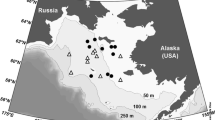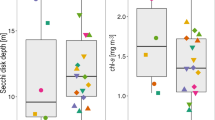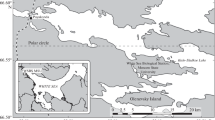Abstract
The abundance of diatoms and heterotrophic bacteria in sea ice rapidly increases during the spring. However, the number and activity of these microorganisms vary with changing environmental conditions and potentially the taxonomic composition of the algal community during this time. In this study, we assessed the spring bottom-ice community composition in Dease Strait, Nunavut, and investigated potential controls of chlorophyll a (chl a), particulate organic carbon (POC), cell abundance, and production from early March until early June. We found that using flow cytometry to estimate photosynthetic nanoeukaryote (2–20 μm) abundance gave results very similar to light microscopy counts, except when pennate diatoms with lengths close to 20 μm, the maximum size detected by flow cytometry, were abundant. Using the average abundance of nanoeukaryotes from the two methods, we documented a change in the size of cells comprising the ice algal community over the spring, from largely pico- (<2 μm), to nano- and microeukaryotes (20–200 μm). This shift in ice algal size corresponded to a bloom in diatoms that drove increases in chl a, POC, and primary productivity. Low-salinity surface waters, limited nutrient availability, as well as seasonally intensifying light in the bottom ice appeared to support dominance of the centric diatom Attheya spp. Increases in the number and productivity of heterotrophic bacteria in this study were correlated with the number of photosynthetic picoeukaryote cells, potentially due to their supply of dissolved organic carbon substrate. Our results suggest that future conditions predicted for the Arctic that include low nutrients and greater light transmission to the bottom of sea ice may favor an ice algal community dominated by centric diatoms versus the more characteristic pennate diatom-dominated community.









Similar content being viewed by others
Explore related subjects
Discover the latest articles and news from researchers in related subjects, suggested using machine learning.References
Agawin NSR, Duarte CM, Agusti S (2000) Nutrient and temperature control of the contribution of picoplankton to phytoplankton biomass and production. Limnol Oceanogr 45:591–600
Belzile C, Brugel S, Nozais C, Gratton Y, Demers S (2008) Variations of the abundance and nucleic acid content of heterotrophic bacteria in Beaufort Shelf waters during winter and spring. J Mar Syst 74:946–956. doi:10.1016/j.jmarsys.2007.12.010
Bowman JS (2015) The relationship between sea ice bacterial community structure and biogeochemistry: a synthesis of current knowledge and known unknowns. Elementa 3:1–20. doi:10.12952/journal.elementa.000072
Bunch JN, Harland RC (1990) Bacterial production in the bottom surface of sea ice in the Canadian subarctic. Can J Fish Aquat Sci 43:1986–1995. doi:10.1139/f90-223
Campbell K, Mundy CJ, Barber DG, Gosselin M (2015) Characterizing the sea ice algae chl a-snow depth relationship over Arctic spring melt using transmitted irradiance. J Mar Syst 127:76–84. doi:10.1016/j.jmarsys.2014.01.008
Campbell K, Mundy CJ, Landy JC, Delaforge A, Michel C, Rysgaard S (2016) Community dynamics of bottom-ice algae in Dease Strait of the Canadian Arctic. Progr Oceanogr 149:27–39. doi:10.1016/j.pocean.2016.10.005
Comeau AM, Philippe B, Thaler M, Gosselin M, Poulin M, Lovejoy C (2013) Protists in Arctic drift and land-fast sea ice. J Phycol 49:229–240. doi:10.1111/jpy.12026
Cota G, Horne E (1989) Physical control of arctic ice algal production. Mar Ecol Prog Ser 52:111–121
Deming JW (2010) Sea ice bacteria and viruses. In: Thomas DN, Dieckmann GS (eds) Sea ice, 2nd edn. Wiley Blackwell Publishing, Malaysia, pp 248–282
Ducklow H (2000) Bacterial production and biomass in the oceans. In: Kirchman DL (ed) Microbial ecology of the oceans. Wiley, Liss, pp 85–120
Ducklow HW (2003) Seasonal production and bacterial utilization of DOC in the Ross Sea, Antarctica. Biogeochem of the Ross Sea 78:143–158. doi:10.1029/078ARS09
Falkowski PG, Owens TG (1978) Effects of light intensity on photosynthesis and dark respiration in six species of marine phytoplankton. Mar Biol 45:289–295
Glaz P, Sirois P, Archambault P, Nozais C (2014) Impact of forest harvesting on trophic structure of eastern Canadian boreal shield lakes: insights from stable isotope analyses. PLoS ONE. doi:10.1371/journal.pone.0096143
Golden KM, Ackley SF, Lytle VI (1998) The percolation phase transition in sea ice. Science 282(5397):2238–2241. doi:10.1126/science.282.5397.2238
Gosselin M, Legendre L, Demers S, Ingram RG (1985) Responses of sea-ice microalgae to climatic and fortnightly tidal energy inputs (Manitounuk Sound, Hudson bay). Can J Fish Aquat Sci 42:999–1006
Gosselin M, Levasseur M, Wheeler PA, Horner RA, Booth BC (1997) New measurements of phytoplankton and ice algal production in the Arctic ocean. Deep Sea Res II 44(8):1623–1644. doi:10.1016/S0967-0645(97)00054-4
Haecky P, Anderson A (1999) Primary and bacterial production in sea ice in the northern Baltic sea. Aquat Microb Ecol 20:107–118. doi:10.3354/ame020107
Hawes I, Lund-Hansen LC, Sorrell BK, Nielsen MH, Borźak R, Buss I (2012) Photobiology of sea ice algae during initial spring growth in Kangerlussuaq, West Greenland: insights from imaging variable chlorophyll fluorescence of ice cores. Photosynth Res 112:103–115. doi:10.1007/s11120-012-9736-7
He J, Inghong C, Iaodong JX, Bo C, Yong Y (2005) Characterization of the summer pack ice biotic community of Canada Basin. Acta Ocean Sin 24(6):80–87
Hsaio SIC (1992) Dynamics of ice algae and phytoplankton in Frobisher Bay. Polar Biol 12:645–651. doi:10.1007/BF00236987
Jackson JM, Allen SE, McLaughlin FA, Woodgate RA, Carmack EC (2011) Changes to the near-surface waters in the Canada Basin, Arctic Ocean from 1993–2009: a basin in transition. J Geophys Res. doi:10.1029/2011JC007069
Kaartokallio H, Søgaard DH, Norman L, Rysgaard S, Tison JL-, Delille B, Thomas DN (2013) Short-term variability in bacterial abundance, cell properties, and incorporation of leucine and thymidine in subarctic sea ice. Aquat Microbiol Ecol 71:57–73. doi:10.3354/ame01667
Kirchman DL (1993) Chapter 58: leucine incorporation as a measure of biomass production by heterotrophic bacteria. Handbook of methods in aquatic microbial ecology. CRC Press, Florida, pp 509–518
Kirchmann D (2001) Measuring bacterial biomass production and growth rates from leucine incorporation in natural aquatic environments. Marine Microbiol 30:227–237. doi:10.1016/S0580-9517(01)30047-8
Kirst GO, Wiencke C (1995) Ecophysiology of polar algae. J Phycol 31:181–199. doi:10.1111/j.0022-3646.1995.00181.x
Lee SH, Whiteledge TE, Kang S-H (2008) Spring time production of bottom ice algae in the landfast sea ice zone at Barrow Alaska. J Exp Mar Biol Ecol 367:204–212. doi:10.1016/j.jembe.2008.09.018
Legendre L, Demers S, Gosselin M (1987) Chlorophyll and photosynthetic efficiency of size-fractionated sea-ice microalgae (Hudson Bay, Canadian Arctic). Mar Ecol Prog Ser 40:199–203
Legendre L, Ackley SF, Dieckmann GS, Gullicksen B, Horner R, Hoshiai T, Melnikov IA, Reeburgh WS, Spindler M, Sullivan CW (1992) Ecology of sea ice biota: part 2. Global significance. Polar Biol 12:429–444
Leu E, Søreide JE, Hessen DO, Falk-Petersen S, Berge J (2011) Consequences of changing sea-ice cover for primary and secondary producers in the European Arctic shelf seas: timing, quantity, and quality. Prog Oceanogr 90:18–32. doi:10.1016/j.pocean.2011.02.004
Leu E, Mundy CJ, Assmy A, Campbell K, Gabrielsen TM, Gosselin M, Juul-Pedersen T, Gradinger R (2015) Arctic spring awakening—steering principles behind the phenology of vernal ice algae blooms. Prog Oceanogr 139:151–170. doi:10.1016/j.pocean.2015.07.012
Li WKW, McLaughlin FA, Lovejoy C, Carmack EC (2009) Smallest algae thrive as the Arctic Ocean freshens. Science 326:539. doi:10.1126/science.1179798
López-Sandoval DC, Fernández A, Marañón E (2011) Dissolved and particulate primary production along a longitudinal gradient in the Mediterranean Sea. Biogeosciences 8:815–825. doi:10.5194/bg-8-815-2011
Maranger R, Bird DF, Juniper SK (1994) Viral and bacterial dynamics in Arctic sea ice during the spring algal bloom near resolute, NWT, Canada. Mar Ecol Prog Ser 111:121–127
Maranger R, Vaqué D, Nguyen D, Hébert M-P, Lara E (2015) Pan-Arctic patterns of planktonic heterotrophic microbial abundance and processes: controlling factors and potential impacts of warming. Prog Oceanogr 139:221–232. doi:10.1016/j.pocean.2015.07.006
Medlin LK, Priddle J (1990) Polar marine diatoms. British Antarctic Survey, Cambridge
Melnikov IA, Kolosova EG, Welch HE, Zhitina LS (2002) Sea ice biological communities and nutrient dynamics in the Canada basin of the Arctic Ocean. Deep Sea Res I 49:1623–1649. doi:10.1016/S0967-0637(02)00042-0
Michel C, Legendre L, Ingram RG, Gosselin M, Levasseur M (1996) Carbon budget of sea-ice algae in spring: evidence of a significant transfer to zooplankton grazers. J Geophys Res 101(C8):18345–18360
Michel C, Nielsen TG, Nozais C, Gosselin M (2002) Significance of sedimentation and grazing by ice micro- and meiofauna for carbon cycling in annual sea ice (northern Baffin Bay). Aquat Microbiol Ecol 30:57–68. doi:10.3354/ame030057
Mikkelsen DM, Rysgaard S, Glud RN (2008) Microalgal composition and primary production in Arctic sea ice: a seasonal study from Kobbefjord (Kangerluarsunnguaq), west Greenland. Mar Ecol Prog Ser 368:65–74. doi:10.3354/meps07627
Miller CB, Wheeler PA (2012) Biological oceanography. Wiley Blackwell Publishing, Malaysia
Mock T, Meiners KM, Giesenhagen HC (1997) Bacteria in sea ice and underlying brackish water at 54″26′50″N (Baltic Sea, Kiel Bight). Mar Ecol Progr Ser 158:23–40. doi:10.3354/meps158023
Mundy CJ, Barber DG, Michel C (2005) Variability of snow and ice thermal, physical and optical properties pertinent to sea ice algae biomass during spring. J Mar Syst 58:107–120. doi:10.1016/j.jmarsys.2005.07.003
Mundy CJ, Gosselin M, Ehn JK, Belzile C, Poulin M, Alou E, Roy S, Hop H, Lessard S, Papakyriakou TN, Barber DG, Stewart J (2011) Characteristics of two distinct high-light acclimated algal communities during advanced stages of sea ice melt. Polar Biol 34:1869–1896. doi:10.1007/s00300-011-0998-x
Niemi A, Michel C, Hille K, Poulin M (2011) Protist assemblages in winter sea ice: setting the stage for the spring ice algal bloom. Polar Biol 34:1803–1817. doi:10.1007/s00300-011-1059-1
Parsons TR, Maita Y, Lalli CM (1984) A manual of chemical and biological methods for seawater analysis. Pergamon, New York
Piwosz K, Wiktor JM, Niemi A, Tatarek A, Michel C (2013) Mesoscale distribution and functional diversity of picoeukaryotes in the first-year ice of the Canadian Arctic. ISME 7:1461–1471. doi:10.1038/ismej.2013.39
Pogorzelec NM, Mundy CJ, Findlay CR, Campbell K, Diaz A, Ehn JK, Rysgaard S, Gough K (2017) FTIR imaging analysis of cell content in sea-ice diatom taxa during a spring bloom in the lower Northwest passage of the Canadian Arctic. Mar Ecol Prog Ser 569:77–88. doi:10.3354/meps12088
Poulin M, Cardinal A (1982) Sea ice diatoms from Manitounuk Sound, southeastern Hudson Bay (Quebec, Canada). III. Cymbellaceae, Entomoneidaceae, Gomphonemataceae, and Nitzschiaceae. Can J Bot 61:107–118
Poulin M, Daugbjerg N, Gradinger R, Ilyash L, Ratkova T, Cvon Quillfeldt (2011) The pan-Arctic biodiversity of marine pelagic and sea-ice unicellular eukaryotes: a first-attempt assessment. Mar Biodivers 41:13–28. doi:10.1007/s12526-010-0058-8
Riedel A, Michel C, Poulin M, Lessard S (2003) Taxonomy and abundance of microalgae and protists at a first-year sea ice station near Resolute Bay, Nunavut, spring to early summer 2001. Fisheries and Oceans Canada: Canadian data report of hydrography and ocean sciences 159
Riedel A, Michel C, Gosselin M, LeBlanc B (2007) Grazing of large-sized bacteria by sea-ice heterotrophic protists on the Mackenzie shelf during the winter-spring transition. Aquat Microb Ecol 50:25–38. doi:10.3354/ame01155
Rózańska M, Gosselin M, Poulin M, Wiktor JM, Michel C (2009) Influence of environmental factors on the development of bottom ice protest communities during the winter-spring transition. Mar Ecol Prog Ser 386:43–59. doi:10.3354/meps08092
Różańska M, Poulin M, Gosselin M (2008) Protist entrapment in newly formed sea ice in the Coastal Arctic Ocean. J Mar Syst 74:887–901. doi:10.1016/j.jmarsys.2007.11.009
Rysgaard S, Glud RN (2004) Anaerobic N2 production in Arctic sea ice. Limnol Oceanogr 49:86–94. doi:10.4319/lo.2004.49.1.0086
Sarmiento JL, Gruber N (2006) Ocean biogeochemical dynamics. Princeton University Press, Princeton
Sherr EB, Sherr BF (1993) Preservation and storage of samples for enumeration of heterotrophic protists. In: Kemp PF, Sherr BF, Sherr EB, Cole JJ (eds) Current methods in aquatic microbial ecology. Lewis Publishers, New York, pp 207–212
Sime-Ngando T, Juniper SK, Demers S (1997) Ice-brine and planktonic microheterotrophs from Saroma-ko Lagoon, Hokkaido (Japan): quantitative importance and trophodynamics. J Mar Syst 11:149–161. doi:10.1016/S0924-7963(96)00035-8
Smith REH, Clement P (1990) Heterotrophic activity and bacterial productivity in assemblages in microbes from sea ice in the High Arctic. Polar Biol 10:351–357. doi:10.1007/BF00237822
Søgaard DH, Kristensen M, Rysgaard S, Glud RN, Hansen PJ, Hilligsoe KM (2010) Autotrophic and heterotrophic activity in Arctic first-year sea ice: seasonal study from Malene Bight, SW Greenland. Mar Ecol Progr Ser 419:31–45. doi:10.3354/meps08845
Søgaard DH, Thomas DN, Rysgaard S, Glud RN, Norman L, Kaartokallio H, Juul-Pedersen-Juul T, Gelfius N-X (2013) The relative contributions of biological and abiotic processes to carbon dynamics in subarctic sea ice. Polar Biol 36(12):1761–1777. doi:10.1007/s00300-013-1396-3
Søreide J, leu E, Berge J, Graeve M, Falk-Petersen SF (2010) Timing of blooms, algal food quality and Calanus glacialis reproduction and growth in a changing Arctic. Glob Change Biol. doi:10.1111/j.1365-2486.2010.02175.x
Strickland JD, Parsons TR (1972) A practical handbook of seawater analysis, 2nd edn. Bulletin Fisheries Research Board of Canada, Ottawa
Tomas CR (1997) Identifying marine phytoplankton. Academic Press, California
Tremblay G, Belzile C, Gosselin M, Poulin M, Roy S, Tremblay J-E (2009) Late summer phytoplankton distribution along a 3500 km transect in Canadian Arctic waters: strong numerical dominance by picoeukaryotes. Aquat Microbiol Ecol 54:55–70. doi:10.3354/ame01257
Tremblay J, Anderson LG, Matrai P, Coupel P, Bélanger S, Michel C, Reigstad M (2016) Global and regional drivers of nutrient supply, primary production and CO2 drawdown in the changing Arctic Ocean. Progr Oceanogr 139:171–196. doi:10.1016/j.pocean.2015.08.009
vonQuillfedt CH, Hegseth EN, Johsen G, Sakshaug E, Syvertsen EE (2009) Ice algae. In: Sakshaug E, Johnsen G, Kavacs K (eds) Ecosystem Barents Sea. Pair Academic Press, Trondheim, pp 285–302
Acknowledgements
Support for this research was provided by a Northern Scientific Training Program grant and Natural Sciences and Engineering Research Council of Canada (NSERC) Canadian Graduate Scholarship to KC, Canada Foundation for Innovation (CFI) and the Canada Excellence Research Chair grant to SR, NSERC Discovery and Northern Research Supplement Grants to CJM, and in-kind support from the Canadian High Arctic Research Station (CHARS). We thank Dr. Michel Gosselin and Ms. Sylvie Lessard for their support. This work represents a contribution to the research programs of ArcticNet, MEOPAR, the Arctic Science Partnership (ASP), and the Canada Excellence Research Chair unit at the Centre for Earth Observation Science (CEOS) at the University of Manitoba.
Author information
Authors and Affiliations
Corresponding author
Electronic supplementary material
Below is the link to the electronic supplementary material.
Rights and permissions
About this article
Cite this article
Campbell, K., Mundy, C.J., Belzile, C. et al. Seasonal dynamics of algal and bacterial communities in Arctic sea ice under variable snow cover. Polar Biol 41, 41–58 (2018). https://doi.org/10.1007/s00300-017-2168-2
Received:
Revised:
Accepted:
Published:
Issue Date:
DOI: https://doi.org/10.1007/s00300-017-2168-2




